If you’re looking to buy a solar battery in 2022, you’ll find at least 32 brands available in Australia. But which is best?
You could pore over the specs; looking at efficiency, backup, peak power etc. Or you could simply ask the people who install and support home batteries every day what they would trust in their own home.
The word ‘trust’ carries a lot of importance in the previous sentence. A home battery is a very dense box of energy, and lithium batteries are susceptible to thermal runaway if things go horribly wrong. That’s a fancy way of saying the worst-case scenario from a dud battery or installation is an explosion and ferocious fire.
I don’t want to scare anyone from buying a home solar battery – I have one on my family home. But I want to impress upon you the importance of buying a good, well-engineered, monitored and supported brand.
And, of course, it needs to be well-installed.
For the second year now, we asked installers in the SolarQuotes network which battery they would install on their own homes in 2022 if:
- Money was no object
- Money was tight, and every dollar counted
The idea is that I would tease out the best high-end and the best budget solar batteries for Australian homes as voted by the people with more skin in the game than most.
The latest evaluation and ranking for best home solar batteries in 2023 have been compiled in a comprehensive article, an essential read for those wanting to stay updated on the top-performing solar storage batteries.
Best High-End Solar Batteries in Australia (Money No Object):
We asked the installers:
What battery would you put in your own home if money was no object?
Here’s what they told us their favourite ‘high-end’ home batteries are:
Best Battery – First Place: Tesla (54% of votes)
Tesla keeps its first place from 2021 with their Powerwall home battery getting more votes than all other brands combined. That’s a solid win.
One installer commented:
“Only Tesla – have tried about 6 brands now. Only Tesla.”
That reflects the Powerwall’s best quality: – it just works and keeps working thanks to over-the-air updates and comprehensive monitoring. This allows remote troubleshooting by Tesla engineers if there is an issue.
The Powerwall also comes with – in my opinion – the best solar battery monitoring app.
Finally, the Powerwall easily optimises its operation with time-of-use tariffs so you can confidently ride through expensive evening peak periods on solar battery power.
The one downside: Powerwall is expensive. Expect to pay $16,000+ installed on your home before any subsidies are applied.
Tesla Powerwall reviews from 350 Australians score an impressive 4.9 star average.
“We purchase Tesla battery system after having solar for some time because when the power went out our solar went down and we were without power, Tesla Battery does a great job it has backed up our large house and sheds on Rural Property for up to 4 days at a time during hot summer. we couldn’t be happier with it, Tesla battery was our best investment and has added property value.”
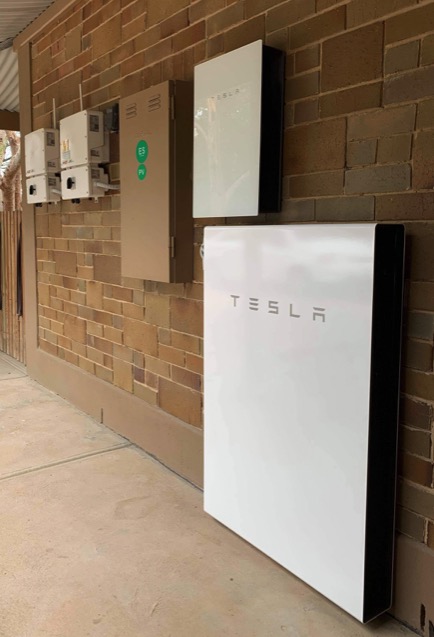
Tesla Powerwall and Gateway installed by Testar
Best Battery – Second Place: BYD (13% of votes)
BYD is a Warren Buffet backed, $100 billion Chinese battery maker. In Australia, their most popular home battery is the modular BYD B-Box Premium, which ranges from 5.1 to 22 kWh and works nicely with the Fronius Gen 24 Hybrid inverter.
We have 24 BYD battery reviews on SolarQuotes with an average 4.8 stars.
“I’ve had the 7 kw BYD Mini for around 6yrs now. BYD have given it a couple of upgrades and is working fine. The only beef I have is the app is controlled from China and the lag is a bit slow and drops out. A text to BYD Australia and the rep here has it fixed in no time usually within 24hrs. Overall, a great battery.”
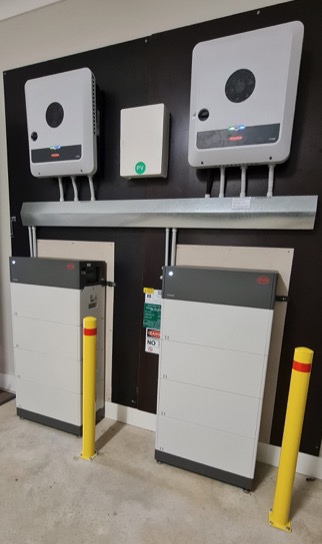
BYB B-Box batteries & Fronius Gen 24 Hybrid inverter, installed by Simmark
Best Battery – Third Place: SolarEdge (11% of votes)
This is an interesting result – because, at the time of voting, SolarEdge’s 5 kW/10 kWh Energy Bank (aka SolarEdge Home Battery) was not yet available in Australia.
That means many installers trust SolarEdge hardware enough to recommend their home battery before they’ve even installed one for a customer.
As far as I can tell, this solar battery will need a SolarEdge Energy Hub Inverter, and – if you want backup – the SolarEdge backup interface box.
Here’s an artist’s impression of the home battery, inverter and backup box from SolarEdge:

Image: SolarEdge
Best Budget Home Batteries In Australia (Every Dollar Counts):
Best Budget Battery – First Place: Tesla (25% of votes)
It seems that many Australian solar battery installers can’t bear the thought of installing anything other than a relatively expensive Tesla Powerwall ($16,000 + installed without a subsidy), even if the customer is on a tight budget. I certainly know a few installers who would rather lose the sale than install anything else.
That’s because the Powerwall installs easily and is generally trouble-free. And because Tesla has made the app so easy to use, there’s very little customer support required after the installation.
For example – when the cellular connection in early Powerwalls stopped working, the app made the switch over to WiFi a piece of cake for the customer. Many other brands would have required a service visit.
Well done Tesla – the Powerwall is a phenomenal piece of technology – it just needs to start dropping in price instead of increasing. Please?
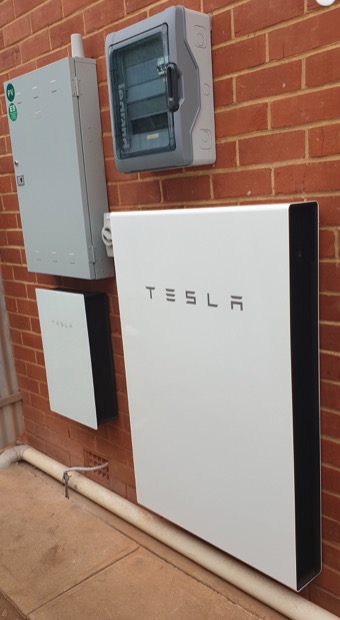
Tesla Powerwall installed by DQ Electrical
Best Budget Battery – Second Place: Sungrow (19% of votes)
Sungrow – who last week got gold for the best budget inverter in Australia, score silver for the best budget home battery.
Their new, stackable battery can go from 9.6 kWh to 25.6 kWh in 3.2 kWh increments. It is only compatible with Sungrow hybrid inverters.
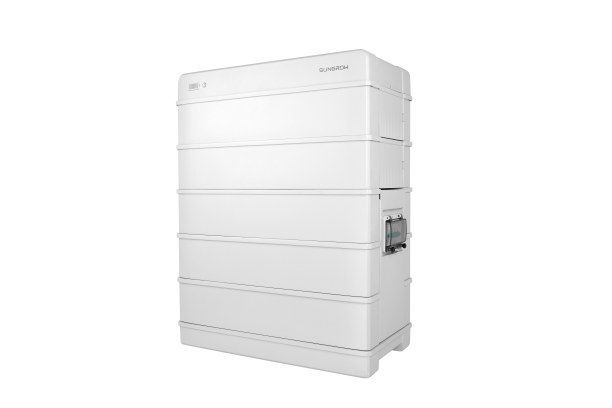
Sungrow’s latest home battery, the great value, stackable SBR096
In my opinion, this is the only truly budget solar battery on the podium. It’s about 40% cheaper per kWh than the Powerwall and about 30% cheaper than the BYD.
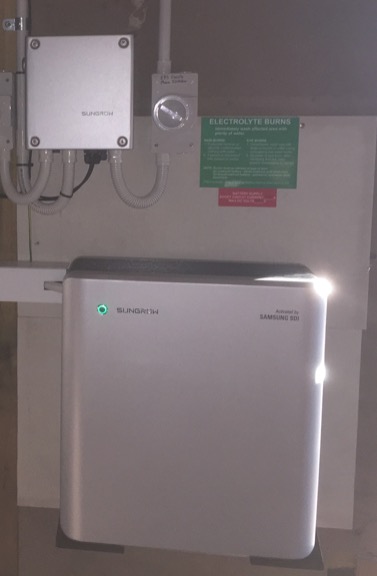
An older model Sungrow battery installed by SolarGain Gippsland
We have 31 Sungrow battery reviews from Australian owners with an average score of 4.7 stars.
“It’s only a week in but it all seems to be going as expected. Each night the battery drops to about 40% and quickly recharges once the sun rises. This means we have drawn little or no power from the grid since installation.”
Best Budget Battery – Third Place: BYD (9% of votes)
Like Tesla, BYD gets a gong for the best high-end and best budget home battery, reflecting the confidence that many installers have in BYD.
Here are where all the votes went for ‘Best Budget Battery 2022’:
Also check out the results for the best solar panel and best inverter brands as voted by top installers in the SolarQuotes Installers’ Choice Awards for 2022.

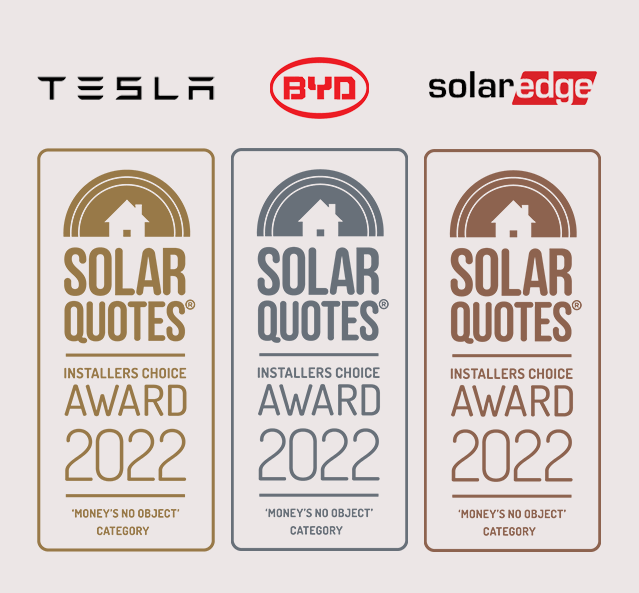
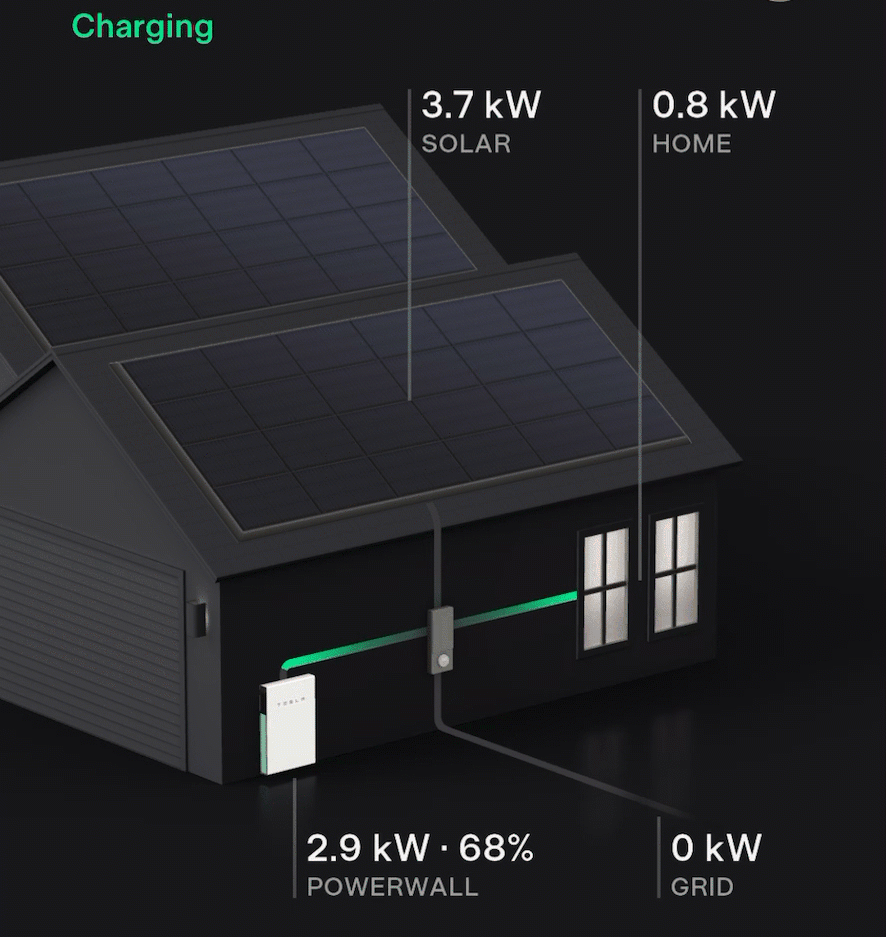
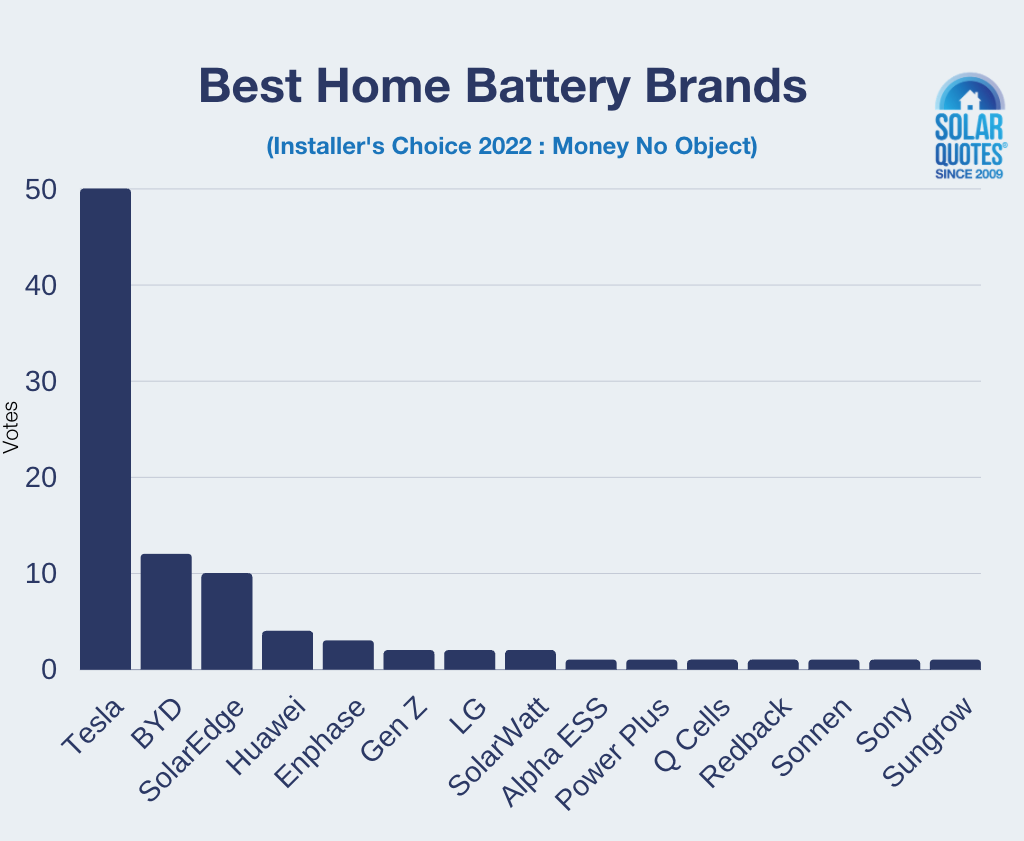
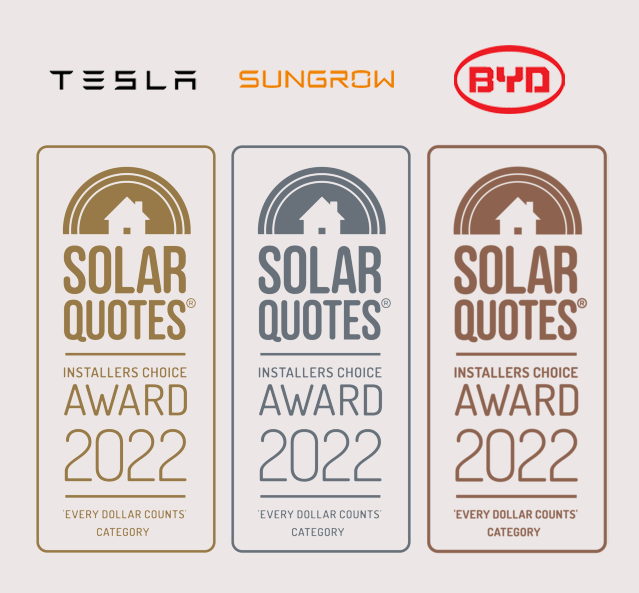
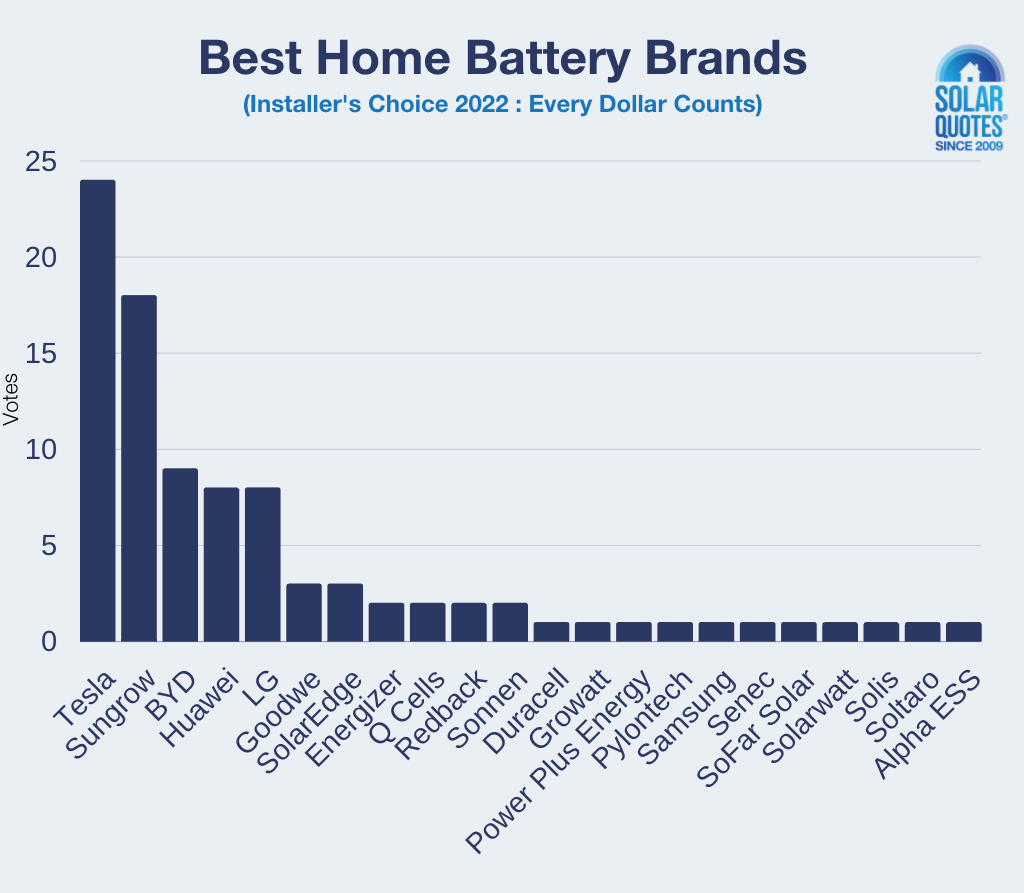
 RSS - Posts
RSS - Posts



I choose LG Chem RESU 16h because it can be DC coupled, which allows me to oversize my two 7.6 kW Energy Hub inverters up to 200% without clipping, much cheaper than Powerwall and allows me to charge from the grid if I decide to switch to time of use rates. I know that they had some fires in Chevy Bolts (~20) but they are replacing all Chevy Bolt batteries at their cost. That is a company that stands behind their product.
Is it true that you can’t charge Powerwall from the grid if you have solar in Australia? Or is that only in the US?
My Powerwall 2 here in Sth Australia charges both from both my PV and from the grid.
Awesome. Thanks so much for confirming this.
Tesla recently updated their monitoring app so you can input the time-of-use electricity charges and times. It then attempts to optimise usage and minimise costs by discharging the battery when grid charges are high. Most of the time it is able charge from the grid at off-peak times, if there was insufficient solar generated during the day (our house has a lot of shade in winter 🙁 ).
The system also gets to know your typical usage and adds that to the optimisation process.
We have also “weathered” a couple of power outages in Sydney over the past year, mostly due to storms, when the Powerwall cuts in before any devices like computers have time to notice. The app also has a “Storm Watch” feature that will automatically top up from the grid if there is a severe storm warning but I haven’t see this in action.
Thomas Martin thanks heaps for the review, I’m actually looking at LG for that exact same reason. I don’t know why LG was dropped off the list, last year it was 2nd best overall and the best for value and got the no 1 spot.
Did Solar quotes just drop it because of the recall? Hell Powerwall has had recalls as well?
Exactly like you said, LG is recalling products and replacing them at their cost, they are being proactive about the whole thing.
If their prices no longer match and that’s why the others beat it for value I can understand but this doesn’t seem to be the case as the Powerwall is up there on no 1 place with “Money being no object” AND best budget / value and it is impossible to be both which how much it costs!
I am starting to get concerned about these types of reports being based on sample sizes not representative of the industry.
Alpha ESS, which I know nothing about, is a huge part of the market but would seem from this report they are a bit player. On the other hand, LG Chem in recent times has had many issues but is ranked ahead of more popular and less troublesome products from Growatt and Powerplus.
Products like Pylontech with high regard in the industry generally seem not to be discussed here, and products like UZ that use the highly regarded CATL cells aren’t in the list at all.
There is no attempt to offer a contrast to the industry opinions and the results of things like the Choice battery tests.
We asked 400 highly regarded installers to vote. They are a busy bunch and about 100 responded. These are their votes. It’s that simple.
The installer constituency that was polled definitely skew to the higher quality end of the market, and they generally shy away from the very cheap batteries.
Feel free to offer a contrast to these industry opinions.
I think the survey is a bit flawed. It’s unlikely many installers will have experience with more than one or two brands to begin with, although some of the larger installers might, but the main reason is what’s important to an installer is not necessarily what’s important to a customer.
Let’s face it – installers are not battery experts and therein lies the problem. eg installing a Tesla “all in one” battery is a relatively simple exercise compared to installing a Pylontech battery in a Victron system with the programming, additional wiring etc, additional equipment like a CerboGX and CTs.
Not throwing any shade on installers but that’s a much more complex install with a much higher expertise level required and even getting an installer prepared to do it is a challenge. Most installers will only install “packages” that consist of hardware they have experience with. So you can’t use a Pylontech or even a BYD 48V battery with many of their preferred inverters – hence a Tesla Powerwall becomes the default option. And don’t get me wrong – the Tesla Powerwall is a great option – it’s just expensive and not very flexible.
For the same reason it’s not surprising that Sungrow came second. It’s just a matter for the installer to configure it as designed with both the battery and hybrid inverter coming from the same manufacturer and the fact that it’s cheaper than equivalent systems is going to give it the “edge”. Well done Sungrow.
Since the main criteria was price, why only mention the price for Tesla (twice)?
Because the Powerwall won both categories and it only comes in one size.
SolarEdge pricing in Australia is unknown.
BYD and Sungrow pricing is given: From the post, “[The Sungrow Battery] is about 40% cheaper per kWh than the Powerwall and about 30% cheaper than the BYD.”
All battery pricing is also here:
https://www.solarquotes.com.au/battery-storage/comparison-table/
no interest in enphase at all?
Hi,
I have 12Kw (approx) of Zenaji Batteries. I cycle them at least twice/day. They are Lithium Titanate. My original set (of early Zenaji batteries) was replaced under warranty due to changes to hardware that in my case I had no problem with, but I wanted to add more batteries, so they replaced the old ones with the new model.
On my system, I have 2 of Victron 5Kw charger/inverters for a 2 phase system. We discharge the battery every night to close to minimum voltage.
These batteries are good for at least 20000 cycles, so much better life than Lithium Ion technologies.
Unfortunately, Zenaji had issues on the Battery life test due to that setup using a SMA Sunny Island inverter, which is not the best setup for this battery.
My new setup has now been running for 12 months. I use very little power from the grid, with abt 16Kw of PV, facing N & W.
Good to hear o for experience with LTO Zenaji battereis. We re the USA distributor. We have sold about 25 units and so far so good. YEs with a cycle life of over 20K cycles that is what one chould call a true lifetime battery. LTO battereis I believe will become more popular as more and more people realize the value of a life long battery at a premium cost.
No mention of Zenaji batteries in this piece, and no surprises lol
Solarquotes basically hero-worships Tesla at the expense of better quality, longer-lasting and higher performing batteries like the Zenaji LTO, which are made in Australia.
Surveys of this type (tiny sample size) reflect the website’s need to bring value to its commercial interests rather than its readers, and should never be trusted. How do I know? Thirty years of experience in the media.
Take a minute to watch this podcast about Zenaji batteries from a former University of Sydney professor (in energy research) Dr Tony Vassallo who chose the Aeons for his own off-grid property based on all the key criteria in choosing battery storage.
He’s not alone either. The owner of R&J Batteries in Australia has Zenaji Aeons on his farm and is now installing our Eternity (32kWh) for his commercial properties.
Roy,
None of the installers voted for Zenaji batteries. That’s why they are not mentioned.
It’s really that simple.
Finn
While I agree there is some “hero-worship” going on, it is not entirely misplaced. I think Finn adequately explains his arrangement with the installers, so it’s not like he’s hiding anything. I also agree it is a very small sample size given the uptake of solar in Australia and around the world.
However, with regards to one design being technically better than another, we should not forget the VHS/Beta battle of the 80’s. Despite Beta being a far better quality video format, the masses (consumers and suppliers alike) for some inexplicable reason (advertising, or media influence, perhaps.) decided to follow VHS. Hence Beta remained more expensive and eventually died out earlier than VHS.
So if the solar industry all worked together to produce the best possible standard package and at good a price as possible, everyone would be better off, including installers who wouldn’t have to know anything about what they’re installing. They’d just have to install it!
Enphase came in 5th place. However, their IQ batteries are not really available in Australia yet.
For the reasons identified by John Mitchell above, it might have been more useful to refer to the results reported by the Battery Test Centre in Canberra, which at least would provide a fair comparison of many brands under identical real-world test conditions. It would also avoid the bias inherent in a market where many people choose Tesla because that’s the one everyone has heard of. Not knocking Tesla, but it’s the battery euivalent of IBM in the world of IT… …
Ronald has exhaustively covered the battery test centre reports in 4 separate blog posts linked to here:
https://www.solarquotes.com.au/blog/battery-test-centre-reports/
Is there no update for this? As that article is a year and a half old now.
How can you have a SolarEdge in top 3 when it has not even been sold in Australia yet?
We have installed quite a few Alpha ESS systems and have not had a single issue to date (knock on wood).
They look great, work well, and are more expandable than most. They are also relatively well priced given that home storage is generally way overpriced. You can buy an EV (if you can actually get one delivered at the moment) for the same price as its equivalently sized home battery which is just nuts! With the EV you get seats, windows, wheels, motors, sound systems etc.
I can’t wait for V2G systems to be released in Australia. That will be a game changer.
I doubt I’d go any of them and instead would build a safer lifepo4 bank as we have on our boat.
We have 840ah @ 24v of EVE 280 cells and 2500w of solar running more 240v refrigeration, HWS, computers, screens, pumps and appliances than we had in the dirt house.
Nightly (no sun) usage is around 30% of total AH available.
If I were going to install lithium-ion batteries, the only option would currently be LiFePO₄.
In the future, there is likely to be come way of avoiding burying the used battery in the ground, but it doesn’t exist yet, which means that no lithium-ion technology is an option for me. There is no other choice yet for cars, because the energy and power density are only available from the bleeding-edge LiNiMC (you know, the ones that keep going up in flames) and its relatives.
The only option that is available for me right now is the Redflow ZBM2, so I’ve installed some of them and will be installing more soon. We’ll see what’s available later this year, when the ZBM3 becomes available.
I have had the Alpha ESS, 10kWh system for about 4 years, and it has been flawless, yet it ranks very lowly in the charts above. The app is excellent and service from support (on rare occasion when needed) is very prompt and helpful. So the survey is not so much about what is best, but what is popular without any real metrics than can be evaluated.
I very happily recommend the Alpha.
Keep up the good work Finn.
Hey Bill, what is your inverter size?
Hi Warren
It is a Solis 5kw single phase. No problems at all after sorting out the initial settings.
Is there anything out there that I can use to “retrofit” a DC Coupled battery system ~10-12kW to my existing system (currently 9.6kW panels to a Fronius 8.2 Primo).
I am getting varying response from installers and the go-betweeners (quotes etc), but they all seem to only know or end up back at an AC couple which is no good for me in QLD given my current inverter size.
I ask them a direct question, Can I install battery DC Coupled between my current panels and current inverter, the science says I can, most don’t seem to know about it, Or am I asking the wrong question.
Do you actually mean “~10-12kWh (of battery capacity)”?
Yeah, missed the “h” 😉
Eveready 5.1kWh Main Battery (AS1-3KS-5.1)
I purchased this battery from the Solar Battery Group last December. I knew that the savings over its 10 year life would not pay back the the cost but I am am insuring against higher electricity costs and lower feed-in tariffs in coming years. I have had no trouble with the battery and everything seems to be working as required. I am considering adding a secondary battery to my existing primary battery to give me a total capacity of 10.2kWh. My roof has 32 solar panels on three arrays giving me a total 7.98kW
Does anyone have an opinion on the Eveready Energy Vault?
How much should the additional 5.1kWh secondary battery cost with installation?
Am I wasting my money adding another battery?
It needs to be an apples Vs apples comparison. This survey has asked installers what they think, and the majority of answers are from owners, not installers. Comparing the installer survey results and the “owner” responses as one probably gives a more balanced outcome. As an owner, there is no way I’d spend the money on a Tesla battery. I went “budget” and bought an Alpha ESS AC coupled 10kWh battery a few years ago. It has worked very well, and represented very good value at the time – I estimated around four years payback. Four of my friends have since bought Alphas based on my experience with them and after inspecting the product and the installation and all are working very well.
I’m sure other battery owners have similar stories about their battery brands as well.
I might be putting a target on my chest but here goes. I bought alpa ess because they are lithium iron not lithium ion so as safe as you get and the reason lithium iron lifepo4 is used in caravans. Also I could only get a 15 yr warranty by signing up to the telsa vpp that offers $220 a year payback but increased my connection charge to the grid by $180 a year… truly… I don’t like vpp cycling my batteries and check the impact on your warranty. I bough and extra 5 kw and getting 15 kw ess for $13110. The extra 5 kw means i will do an overnight cycle of maybe 55% and not 80% for a 10 kw battery. This means the number of cycles should increase giving me a longer lifetime without warranty of course. Just check the cycles and depth of discharge graph for your caravan batteries to see if my logic makes senses
100% agree John Mitchell.
Based on installers is already flawed to start with. I’ve called countless installers and they only install Tesla Powerwall’s and will not touch anything else, despite me asking and never hearing from some of the other big names!
Huge bias issue right there and it has nothing to do with quality.
We need PROPER testing and PROPER statistics, not pure bias preference from installers!
There is a huge issue with batteries as Solar Quotes have stated and that is the price but what isn’t revealed is the price isn’t just the battery but the installation costs.
I was privy to some approx costs for the batteries alone (and that’s not even wholesale) and the amount that installers are charging is highway robbery.
They seem to be grabbing the battery price and doubling it for installation.
I was quoted 6.5k for a LG battery (again not wholesale so they would get it cheaper again) and yet I couldn’t get it installed for under 10 – 12 grand. This was for a RESU10 (10kwhr battery)
I asked how long they took to install and it was approx 3 – 4 hours they said.
So that is $1000+ an hour.
So something that doesn’t even give ROI actually COULD if the installers were not ripping everyone blind.
We’d be selling and installing a hell of a lot more batteries.
Unfortunately, the low reliability of batteries results in high installation charges because installers may have to return multiple times troubleshoot issues, fix problems, and often entirely replace batteries. They also have to cover the chance they’ll have to take over the manufacturer’s warranty for up to 10 years in most cases if the manufacturer goes bankrupt. Installation costs will come down once battery system reliability goes up.
Ronald sorry but that’s a pretty poor excuse to be honest. I know loads of people with batteries and none of them have had to even make a warranty claim yet and they’ve had them for years.
Half those people ended up doing a DIY job as installation cost was the primary reason stopping them getting a battery as it essentially doubled the overall cost.
The first battery manufacturer who comes out with a DIY kit will absolutely dominate the market, which in all honesty couldn’t come soon enough.
They are already getting close with the Zenaji Lithium Titanate Batteries. You can do that yourself, you simply need an electrician to sign off on it afterwards (or even getting one to do it all wouldn’t cost near what battery installers are charging) so despite the battery being more expensive, you’d save that in installation costs and it has a 20 yr warranty.
Also your reasoning about if the company goes broke they have to warrant it, is MUCH less likely than the company that installs them going broke. The amount charged just makes room for dodgy companies to get rich quick, wind down the business and start another one under another name to avoid everything you’ve mentioned yet keep the huge amount you pay.